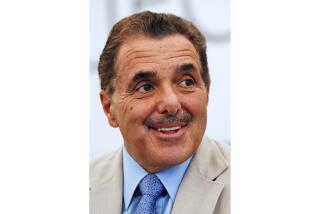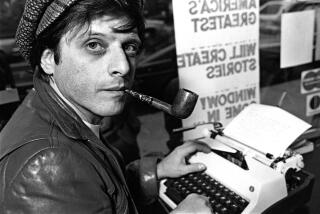Jacob Zeitlin, Authors’ Friend and Noted Book Seller, 84, Dies
- Share via
Jacob (Jake) Zeitlin, friend and confidant to many of the great American authors of this century, an inveterate bibliophile who made and lost several fortunes in the pursuit of his beloved printed word, and for four decades Los Angeles’ most celebrated seller of books, died Sunday night at his home in West Hollywood.
He was 84 and had been in deteriorating health since undergoing heart bypass surgery several weeks ago.
His wife, Josephine Ver Brugge; his son, Joel Leob Zeitlin, and his daughter, Adriana Katlin, were with him at the time of his death. In addition, he leaves another daughter, Judith Armstrong Zeitlin, and another son, David John Zeitlin. Funeral arrangements are pending.
A Lifetime Devotion
Both soft spoken and outspoken, Zeitlin devoted his life to the cognition of literature, be it rare books passed down from ancient masters or the more recent efforts of such pals as Aldous Huxley, D. H. Lawrence, William Faulkner and Carl Sandburg.
In his early, struggling years, he fought censorship, often to the detriment of his own precarious financial situation, hosted the first western exhibition of Edward Weston’s photography when photography was looked on more as a hobby than an art form, and in his later years had become an appraiser of collections for such prized clients as the Getty Museum.
It was only in this latter period that he achieved the financial independence that had eluded him earlier, quietly confiding to a reporter in 1984 that “I finally became a millionaire when I turned 80.”
In essence, he was the ongoing, dominating and most artistically influential imperator of literary Los Angeles, which was little more than a fiefdom when he began his bookselling career in September, 1925.
That was three years after he had hitchhiked and walked his way to Los Angeles from Fort Worth, Tex., where he had been a practicing poet who also eked out a meager existence as a book reviewer for the local newspaper.
Modest Beginning
Here he was forced to shovel fertilizer at 25 cents an hour at the old Doheny estate in Beverly Hills. Later he met and arranged speaking engagements for the touring Sandburg and writers Vachel Lindsay and Edgar Lee Masters before embarking on a modest selling career in the downtown book departments of May Co. and Bullocks. He wrote as he sold and in 1926-27 published poetry with introductions by Sandburg while contributing a group of folk songs to Sandburg’s “American Song Bag.”
The first of the Zeitlin-owned shops, which featured exquisite printing in often cluttered surroundings, was at 567 S. Hope St., across from the Bible Institute. A special edition of the London-based The Book Collector, printed in 1982 on the occasion of Zeitlin’s 80th birthday, described the location as appropriate, “because Jake had few other assets (besides Hope).”
Although he had only a few books to sell and paying the rent was chancy, one of the first of what came to be countless unselfish acts took place when Zeitlin printed and issued a map showing the location of the other book shops then around 6th Street. From that map and the shop owner’s own erudition and enthusiasm there began to gather around Zeitlin the men who would form the touchstone of the local book world--Ward Ritchie, printer par excellence; Lawrence Clark Powell, the preeminent librarian, and Grant Dahlstrom, the graphics designer.
He moved from Hope to larger quarters on 6th and prevailed on his friend Lloyd Wright, son of master architect Frank Lloyd Wright, to design a compact yet attractive book shop whose shelves could contain not only the priceless first editions of “Tom Jones” and “Gulliver’s Travels,” that had been entrusted to Zeitlin’s care by a visiting British dealer, but thousands of other less expensive volumes which the then 26-year-old Zeitlin could sell more easily.
To that and other of his shops came William Saroyan, Robinson Jeffers, Carey McWilliams, plus a diversity of nationalities and characters in the oddest sense of that word.
Start of the Circuit
Wrote McWilliams decades later: “There have been few visiting British novelists, Indian philosophers or Viennese metaphysicians who have not drifted into his establishment, to be hospitably received, properly briefed and then sent forth along the Zeitlin circuit.”
By now Zeitlin had established contact with fellow book enthusiasts across the country and in Europe. He became interested in books about science and the scientists. Works by and about Leonardo da Vinci and Florence Nightingale competed for space with First and Second Shakespeare Folios and he moved to still larger quarters on 6th, then further west to the former stables of the Earl estate on Carondelet Street near Westlake Park. Finally he moved to La Cienega Boulevard, where he has maintained his business in a replica of a Pennsylvania Dutch barn that book lovers have come to know as the Red Barn at 815 North.
At the same time as Zeitlin was beginning to gather the famed Leonardo collection, which eventually came to UCLA, he received a letter from a young woman in Kansas. She described herself as 5 feet 5 inches, with dark hair and a good personality. Her name was Josephine Adriana Ver Brugge.
Zeitlin remembered in a 1975 interview that “Ver Brugge would make an awfully nice masthead for a book shop.”
It would and did, for Zeitlin and Ver Brugge were married and the shop became “Zeitlin & Ver Brugge,” dealers in “Rare Books in Science and Medicine, Old Master Prints and Drawings” to quote from the sign on the Red Barn.
Prized Collection
They came to handle Galileo manuscripts, first editions of Copernicus, scores crafted by Beethoven and letters from George Washington.
With Ritchie and others he formed the Rounce & Coffin Club to promote fine printing and helped establish the Ampersand Press, the first hand press to operate in Los Angeles.
To his shops came not just the literati of the West but some of the most celebrated personalities of the era: Rufus Von Kleinsmid, the colorful president of USC; Frank J. Hogan, the articulate attorney who supposedly was paid a $1-million fee for winning acquittals in the Teapot Dome scandal; the Rev. W. Bartrand Stevens, Episcopal Bishop of Los Angeles.
And a young John Steinbeck, whom Zeitlin would ferry up and down the coast in his Model A.
He published a magazine he called Opinion, founded the Primavera Press and in 1935 wrote “Lilliputian Libraries,” believed the first widely disseminated article on microfilm storage. He became agent for Frieda Lawrence, D. H. Lawrence’s widow, and in 1937 arranged for Aldous Huxley to come to Southern California and write for films, the beginning of a close relationship that lasted until Huxley’s death in 1963.
Letters Preserved
He corresponded regularly with William Faulkner, Huxley’s brother, Julian, Rockwell Kent and Jeffers, and never threw away much of that correspondence or anything else for that matter.
When he gave to UCLA the 27 big boxes that comprised his archives several years ago the researcher entrusted with them counted 81,000 separate items.
“Everything is very, very dusty,” the researcher wrote, “and presents, on the whole, a suspiciously nibbled appearance. . . . I did a lot of dusting, primarily by inhalation, brushed out countless roach legs, moth wings and mouse droppings.”
Zeitlin by the time of his move to the Red Barn in 1948 had become an icon of the printed word. He addressed library associations, lectured against censorship, received honorary university degrees and, in 1964, on the 400th anniversary of Galileo Galilei’s birth, delivered a paper in Florence on the astronomer-physicist.
He procured graphic arts collections for UCLA, lectured on bibliography at campuses around the world where he also established book collecting prizes, and became an international authority on medical books.
Major Sale to Getty
In 1983 he achieved the most significant financial milestone of his life. He sold a collection of 144 illuminated manuscripts ranging from the 7th to the 16th century to the Getty Museum for $30 million, possibly the largest single rare-book sale in the world.
He told an interviewer it was “the most exciting event” of his career. But selling books, for any price, was always exciting to the senior member of Zeitlin & Ver Brugge, Booksellers.
“When I sell a man a good book,” Zeitlin would say in later years, “I am the happy transmitter of a precious thing and I feel I have justly earned my profit.”
More to Read
Sign up for our Book Club newsletter
Get the latest news, events and more from the Los Angeles Times Book Club, and help us get L.A. reading and talking.
You may occasionally receive promotional content from the Los Angeles Times.






